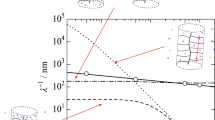Summary
A-B block copolymers in a selective solvent—good for the B-species and bad for the A-species—form micellar aggregates with a compact A-core with a corona (brush) of B «hairs» reaching into the solvent. Whereas polystyrene(PS)-polyisoprene(PI) in decane forms spherical micelles with a PS core of about 10 nm radius, polyethylene(PE)-polyethylenepropylene(PEP) forms micellar platelets, the shape of which is goverend by the habitus of PE crystallites forming the core. These planar aggregates have large (several hundred nanometers) lateral extension and a core thickness in the range of 10 nm. Both systems are model systems for polymer brushes, either on a spherical surface or planar. Neutron spin-echo experiments allow for the investigation of the dynamics of the brushes which reflects their viscoelastic properties. Results of neutron small-angle and spin-echo investigations are reported. The brush dynamics is explained using a model based on an idea of de Gennes describing the brush properties in terms of scaling relations for osmotic pressure and viscosity of a semi-dilute solution with inhomogeneous density.
Similar content being viewed by others
References
S. T. Milner:Science,251, 905 (1991) and references therein.
Pik-Yin Lai andE. B. Zhulina:J. Phys. II,2, 547 (1992).
S. T. Milner, T. A. Witten andM. E. Cates:Macromolecules,21, 2610 (1988).
N. Dan andM. Tirell:Macromolecules,25, 2890 (1992).
P. G. de Gennes:Macromolecules,13, 1069 (1980).
S. Alexander:J. Phys. (Paris),38, 983 (1977).
M. Daoud andJ. P. Cotton:J. Phys. (Paris),43, 531 (1982).
P. G. de Gennes:C. R. Acad. Sci. Paris Ser. II,302, 765 (1986).
B. Farago, M. Monkenbusch, D. Richter, J. S. Huang, L. J. Fetters andA. P. Gast:Phys. Rev. Lett.,71, 1015 (1993).
P. G. de Gennes:Scaling Concepts in Polymer Physics (Cornell University Press, Ithaca, N.Y., 1979).
NG3 is a SANS machine at the National Institute of Standards and Technology in Gaithersburg, USA.
F. Mezei (Editor):Neutron Spin Echo Proceedings, Lecture Notes in Physics,128 (Springer, Berlin, 1979).
MESS is a spin-echo spectrometer in the guide hall of the Orphee reactor at the Centre d’Etudes Nucleaires (CEN) Saclay and is operated by the Laboratoire Leon Brillouin (LLB), Laboratoire Commun CEA-CNRS.
P. G. de Gennes andP. Pincus:J. Chim. Phys.,74, 616 (1977).
T. Tanaka, L.O. Hocker andG. B. Benedeck:J. Chem. Phys.,59, 5151 (1973).
M. Doi andS. F. Edwards:The Theory of Polymer Dynamics (Oxford University Press, Oxford, 1986), p. 164.
Recent experiments with a 10% solution in a Couette-type shear cell performed at the SANS instrument in Risø.
Author information
Authors and Affiliations
Rights and permissions
About this article
Cite this article
Monkenbusch, M., Schneiders, D., Richter, D. et al. Aggregating block copolymers as model systems to study polymer brush dynamics. Il Nuovo Cimento D 16, 747–755 (1994). https://doi.org/10.1007/BF02456720
Received:
Issue Date:
DOI: https://doi.org/10.1007/BF02456720



